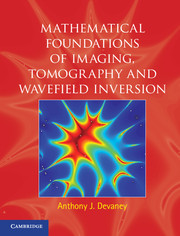Book contents
- Frontmatter
- Contents
- Preface
- 1 Radiation and initial-value problems for the wave equation
- 2 Radiation and boundary-value problems in the frequency domain
- 3 Eigenfunction expansions of solutions to the Helmholtz equation
- 4 Angular-spectrum and multipole expansions
- 5 The inverse source problem
- 6 Scattering theory
- 7 Surface scattering and diffraction
- 8 Classical inverse scattering and diffraction tomography
- 9 Waves in inhomogeneous media
- 10 Time-reversal imaging for systems of discrete scatterers
- 11 The electromagnetic field
- Appendix A Proof of the scattering amplitude theorems
- Appendix B Derivation of the generalized Weyl expansion
- References
- Index
4 - Angular-spectrum and multipole expansions
Published online by Cambridge University Press: 05 July 2012
- Frontmatter
- Contents
- Preface
- 1 Radiation and initial-value problems for the wave equation
- 2 Radiation and boundary-value problems in the frequency domain
- 3 Eigenfunction expansions of solutions to the Helmholtz equation
- 4 Angular-spectrum and multipole expansions
- 5 The inverse source problem
- 6 Scattering theory
- 7 Surface scattering and diffraction
- 8 Classical inverse scattering and diffraction tomography
- 9 Waves in inhomogeneous media
- 10 Time-reversal imaging for systems of discrete scatterers
- 11 The electromagnetic field
- Appendix A Proof of the scattering amplitude theorems
- Appendix B Derivation of the generalized Weyl expansion
- References
- Index
Summary
The Green-function solution to the radiation problem given in Eq. (2.23) of Chapter 2 represents this solution in terms of a superposition of outgoing spherical waves with each spherical wave being weighted by the source amplitude at that point. This solution was derived starting from the fact that the Helmholtz equation is linear and, hence, can be represented as a superposition of elementary solutions to the equation when excited by delta functions; i.e., as a convolution of the source term with a Green function that satisfies the same outgoing-wave condition, namely the Sommerfeld radiation condition (SRC), as is satisfied by the radiated field. Alternative representations of the field can also be obtained by making use of the linearity of the Helmholtz equation and the fact that the radiated field satisfies the homogeneous Helmholtz equation everywhere outside the source region τ0. In particular, as we have seen in the last chapter, it is possible to represent the field in such regions in terms of an expansion of eigenfunctions of the homogeneous Helmholtz equation such as the plane waves or multipole fields. Indeed, in Examples 3.3 and 3.5 of Chapter 3 we expanded outgoing-wave fields such as the radiated field in a plane-wave expansion and a multipole expansion, respectively, with the expansion coefficients (planewave amplitudes and multipole moments) determined directly from boundary values of the field. We continue with this task in this chapter, where we develop plane-wave and multipole expansions for the radiated field directly in terms of the source Q rather than in terms of the boundary value of the radiated field.
- Type
- Chapter
- Information
- Publisher: Cambridge University PressPrint publication year: 2012
- 1
- Cited by



